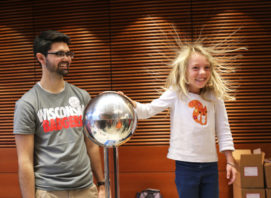Supply & demand mismatch leaves STEM jobs unfilled
Additional writing and reporting provided by Natalie Taylor and Julia Wall.
More businesses than ever are looking for workers skilled in the fields of science, technology, engineering and math (STEM). But companies and trained workers aren’t always finding each other, causing headaches for recruiters and leaving highly educated people out of a job.
Each month in the U.S. there have been about 3 million job openings in all fields have been unfilled since February 2011, according to the U.S. Department of Labor.
According to a 2012 ManpowerGroup survey on talent shortages, 49 percent of employers in the U.S. report having difficulties filling positions, and 44 percent of them reported that this difficulty is related to an overall lack of experience among candidates.
GEOGRAPHY
Betsy Brand, executive director of the American Youth Policy Forum, an organization that educates and informs policy makers on the state and national level to improve education, believes some of the mismatch that occurs between job seekers and employers is related to geography. While on paper it might look like schools are graduating the right number of students in STEM fields, those graduates may not be living where the jobs exist.
“It doesn’t matter if you have a lot of demand if it can’t reach the supply,” Brand said.
Texas is in second place in projections for the highest job growth in STEM fields, yet the number of students earning science or engineering degrees at the undergraduate or graduate level is low compared to the rest of the country. North Dakota, on the other hand, has the worst job outlook for STEM fields in the country, yet the state has one of the highest number of graduates in science and engineering, according to the Alliance for Science & Technology Research in America, an educational research organization.
In some places, businesses are competing with each other for a limited pool of qualified applicants.
Larry Rappl is a human resource manager at WebAssign, a Raleigh, N.C.-based company that creates and delivers an online homework tool to more than a million students and 8,000 teachers in science and mathematics. He said that one of his company’s biggest challenges lies in hiring candidates with good engineering skills.
“I think it’s more of a market factor for this area, in that engineers are in really high demand, and they don’t seem to have been affected by the economy very much,” Rappl said.
WebAssign is located in close proximity to North Carolina’s Research Triangle Park, so it competes for workers with more than 170 global companies like IBM, Cisco and GlaxoSmithKline.
“We’re in the same [situation] as any other software company that’s trying to hire engineers,” said Joe Kedra, corporate recruiter at WebAssign. “We have to look at really trying to be an employer of choice in the area with the benefits package, the pay, everything that we offer in order to compete.”
COMBINATION OF SKILLS AND PASSION
Rappl also said finding applicants with the right combination of skills can be difficult.
“With the folks that we’re looking for, they not only need to be the subject matter experts in their STEM field, but they also do need a little bit of a programming background as well,” Rappl said. “Usually that combination isn’t the easiest thing to find.”
Mike Laut, owner of Laut Design, a company specializing in product development and marketing, said for his business the problem isn’t finding someone with the right credentials, it’s finding someone with the right talents, experience and passion for the work.
“We look for people who would do this for fun, even if they weren’t getting paid,” Laut said. “I’m interested in what they want to do with their career and the work that they can show me.”
Steve Brechbiel, senior director of community relations at Quintiles, a global pharmaceutical company working in clinical research and sales said the job market has shifted to higher technology skills, requiring more people with strong math and science backgrounds.
STEM occupations in general are projected to grow by 17 percent from 2008 to 2018, compared to 9.8 percent growth for non-STEM occupations, according to the Economics and Statistics Administration of the U.S. Department of Commerce.
“The jobs where the growth has been are not necessarily aligned with where our focus in education has been,” he said. “And I think that is really what STEM is about.”



